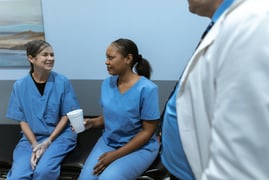Improving Patient Experience With SPARK® Fusion
6 minute read | 24/01/2024

As the NHS braces itself for the pressures and challenges associated with winter, the needs and expectations of patients remain the same — and understandably so.
With an inevitable spike in seasonal illnesses, patient intake volume will swell to an uncomfortable level for many Trusts. However, that doesn’t mean patients are likely to expect any dip in quality of care, irrespective of any seasonal nuance.
Seasonality aside, public satisfaction with the NHS dropped again to its lowest-ever level in recent times — a bleak foreshadowing of what will no doubt be another testing few months for Trusts.
Although we’ve taken steps forward in some aspects of patient care, there’s still work to do. With more technology at our disposal than ever, several innovative ways exist to improve the patient experience.
With a proactive approach to capitalising on new government investment, Trusts can effectively equip themselves for short- and long-term challenges.
Through the lens of SPARK® Fusion, let’s examine how it can influence the patient experience with a detailed overview of how your Trust can benefit ahead of and beyond the difficulties of winter.
Easier on-demand care services
While frontline staff no doubt work hard to service patients individually with the best level of care at all times, the harsh reality is that in times of stretched demand (like winter, for instance), this gets harder through outdated traditional methods.
However, the SPARK® Fusion bedside units make it much easier for staff to attend to patients on-demand and for patients to get access to care right at the precise moment they need it.
Three critical functions make it an asset for the overall patient experience.
Nurse call
Whenever a patient needs the attention of a staff member, they can simply engage through the iPad itself, with simplified communication that doesn’t waste precious time or resources.
Why? That’s because staff can access patient records and health information from the units themselves at the exact moment. Essentially, this means no patient engagement or visit to the bedside is wasted, and the patient gets actual value from each interaction exactly when they need it.
Plus, the in-app request feature displays icons for different needs – so the patient can select exactly what they need and the request is filtered to the relevant staff member. These are things like, ‘glass of water’, ‘need the bathroom’, ‘extra pillow’, ‘shower’ etc.
Meal ordering
Again, much like visits, patient meal times can be rigid, resulting in dissatisfaction and wastage that costs the NHS millions each year.
With SPARK® Fusion, patients can use the in-app function to read about the nutritional elements of the meal, including the ingredients etc – with images of the food so they know exactly what to expect.
Plus, they will only ever be shown foods that they actually can eat (i.e. meet their specific dietary requirements).
Patients can also select portion sizes and the food is uniquely linked to them as a patient. So, for instance, if they were to move beds for whatever reason, the meal will follow (rather than being sent/delivered to the old bed and therefore be wasted).
Again, all this makes for a more comfortable experience, giving patients greater control of when they’d like to eat, just as they would have if they were at home as normal.
Room control
One of the basic aspects of ensuring those in care remain comfortable is their general, physical environment.
When staff resources are stretched, it’s more difficult for them to stay on top of patient demands at any time. For example, this would include the ward environment regarding temperature and lighting.
Thanks to access to the bedside units, SPARK® Fusion empowers patients with more control over their surroundings with access to room control. Patients can directly and independently influence things like lighting and room temperature in their own space more seamlessly from their fingertips, ensuring more comfort on-demand without any need to lean on staff resources whatsoever.
More feedback channels for improvement
One of the things that many people may overlook when considering how the patient experience can be improved is perhaps providing them with more of an ability to ‘have their say’.
Feedback is more valuable than ever, not just for the benefit of patients currently undergoing treatment but also for the wellbeing of future benefits and the quality of care staff can provide them.
SPARK® Fusion opens the patient feedback loop like never before, with better proactive access to patient-reported outcome measures (PROM) and patient-reported experience measures (PREM) surveys. These give Trusts invaluable data for future improvements to the experience in particular.
They also empower current patients by giving them more opportunities to influence the population's experience, making them feel more valued.
Keeping patients suitably entertained
Bedside patient entertainment isn’t a new thing. In fact, this has continually evolved over the years as new technology (and funding) has accommodated.
But, with an ageing population and more people in tune with advances in new technology, it’s fair to say ‘basic’ tech for entertainment is a thing of the past.
With more TV, radio and internet possibilities in people’s homes than ever before, it’s time to reconsider the amenities available within the current healthcare system, however stretched.
It’s becoming more of an expectation to accommodate the things some of the more vulnerable people within our society are now becoming used to. For many, with a seismic shift in routine comes a significant downfall in health, so it’s paramount that Trusts recognise this at the triage stage to accommodate patients suitably.
Of course, this is easier said than done. But, with SPARK® Fusion, the possibilities for patient entertainment are expanded tenfold thanks to the implementation of bedside iPads.
Gone are the days of a simple bedside television. SPARK® Fusion opens the door to TV, radio and internet through one single device assigned to the patient for the duration of their treatment. This empowers patients with more ownership of the entertainment functionality — and single, seamless access to not just entertainment but also everything else to support them during their stay, which we’ll explore further in this guide.
More seamless connection to family and friends
Patient visits have always been a valued commodity for those within the care cycle, but again, thanks to new technology, new possibilities enable a far less limited experience.
With rigid visiting hours in many hospitals, some may argue that the current format doesn’t work for a certain patient demographic. In fact, it has been said that a feeling of isolation during the care cycle can lead to a 29% increased mortality risk, especially in older patients.
Therefore, the need for a more on-demand means of communication is more critical than ever for many patients and can be a massive help for staff in ensuring no downturns to patient wellbeing during their stay.
SPARK® Fusion presents an opportunity to open up communication channels like never before, with seamless 24/7 connectivity from the bedside.
With their own iPad, patients can engage in face-to-face calls with friends and family whenever they want, reducing reliance on rigid visiting hours and giving them more comfort and accessibility to those that matter most in times of isolation.
Putting the patient experience at the heart of healthcare operations
The right investment can ensure short-term hurdles like winter are more easily overcome while building for a better operational set-up in the long term.
Commitment to a solution that works for staff and patients will make for a better healthcare system, with more focus on wellbeing and better patient outcomes regarding readmission rates, satisfaction and wider issues like bed blocking.
SPARK® Fusion has the power to ensure patients are better informed, entertained and engaged while ensuring staff remain fully integrated throughout the care cycle.
For more information on how you can leverage the power of SPARK® Fusion to improve the patient experience, contact us today and let’s discuss how we can set your Trust up for success ahead of a busy winter period and beyond.
Or, for a more detailed insight into patient experience and the critical role it has to play in the future of healthcare, download our in-depth patient experience guide.
About the author
Rebecca O'Donovan
Becky is the Marketing Director at SPARK TSL, of whom she has worked for since 2012. She is responsible for high-level marketing strategy focusing on lead generation and aiding the vision of the business to ensure business growth.
More articles by the author
Related articles
 SPARK® Fusion
SPARK® Fusion
How SPARK Fusion® Can Offer NHS Support
 The SPARK Solution
The SPARK Solution
Analysing NHS Winter Pressures and Exploring Possible Solutions
As winter gradually creeps towards us, it’s time to face the reality of all the challenges the season can ...
 Healthcare Industry
Healthcare Industry
How The NHS Can Save Money With Electronic Meal Ordering
In 2020, an independent review recommended that every hospital in the UK implement an electronic meal ...

